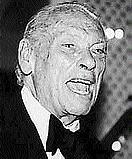
PRINGLE
WESTERN BUREAU:
Jamaica's first director of tourism and former deputy high commissioner to the United Kingdom, John Pringle, died on Tuesday morning in London, England.
The 81-year-old pioneer who was credited with the title 'Father of modern tourism' lost a long battle with the debilitating Alzheimer's disease.
Mr. Pringle, founder of the highly acclaimed Round Hill Hotel and Villas - the first resort of its kind in the Caribbean - which is noted for attracting several prominent clienteles from across the globe and which gained worldwide attention and recognition through cover stories in TIME and LIFE magazines.
He spent the last 30 years in London with his wife Liz and daughter Shawn.
Established 'brand jamaica'
"He is the man who really established 'Brand Jamaica'," said former Minister of Tourism and cousin of the former director, Ambassador Frank Pringle. "He is the man who placed Jamaica firmly and for the first time on the front page of the international tourism map."
In a statement yesterday, Tourism Minister Aloun Assamba noted that Mr. Pringle was responsible for laying the foundation of what has become a global fascination with Jamaica.
"At the time of his incumbency, the tourism portfolio was not yet at the stage where it was assigned full ministerial clout, and as such, it was a make or break situation," Mrs. Assamba said. "This was long before the marketing of nations and the positioning of global brands became fashionable."
The minister described him as a shrewd marketer who saw the possibility for progress and believed that the country could mature into a destination of choice by making the right choices.
Acknowledging his passing as one of sadness, director of tourism, Basil Smith said Mr. Pringle's antecedent tenure from 1963 to 1967 was marked by a period of rapid growth with visitor arrival records being repeatedly set and broken.
"At that time there was no Ministry of Tourism, just a Tourist Board with 30 members of staff. The astute Pringle sought to boost Jamaica's tourism by strengthening the marketing capacity of the JTB with memorable advertising presence in regional newspapers and on mainstream North American television. He established the blueprint, which still guides the use of the JAMAICA logo to this day. His marketing prowess paid off and within four years, revenues from the industry grew threefold."

